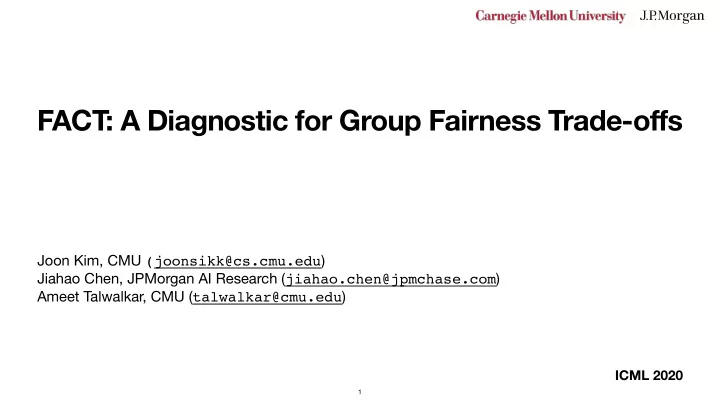

FACT: A Diagnostic for Group Fairness Trade-offs Joon Kim, CMU (joonsikk@cs.cmu.edu ) Jiahao Chen, JPMorgan AI Research ( jiahao.chen@jpmchase.com ) Ameet Talwalkar, CMU ( talwalkar@cmu.edu ) ICML 2020 1
Fairness in ML is becoming more important • More application areas with societal impact • Credit decision/Loan approval • Healthcare provision • Recidivism prediction • Facial recognition • Quantitative notions of fairness: • Individual fairness • Group fairness • Representation fairness • Counterfactual fairness … ICML 2020 2
Why Group Fairness? • Widely studied both in social sciences as a concept of disparate impact • Practical instantiations • p-percent rule : among the accepted subjects, the ratio between the subjects having a certain sensitive attribute to the subjects that do not have the attribute, should be no less than p:100. (U.S. Equal Employment Opportunity Commission) • Intuitive to understand, even for non-ML experts • Active area of research in ML • predictive equality, predictive parity, demographic parity, equalized odds, equal opportunity, class balance, calibration, conditions accuracy equality … ICML 2020 3
… but it comes with several trade-offs. • Type1. Fairness vs. Fairness (impossibility and incompatibility) • “It is not possible to satisfy certain multiple notions of fairness simultaneously unless some strong assumptions about the data and the model are satisfied.” • Kleinberg et al. 2017, Chouldechova 2017, etc. • Type2. Fairness vs. Performance • “Imposing fairness conditions tend to decrease the model’s predictive performance.” • Zafar et al. 2015, Menon and Williamson 2018, etc. How to view them under a simple unified perspective? ⇒ ICML 2020 4
Towards a systematic characterization of trade-offs fairness Type2 Trade-o ff Type1 Trade-o ff performance Incompatible fairness notions x x o x x x Model fairness predictive performance FACT Diagnostic ICML 2020 5
We will cover… • Fairness-confusion tensor (FACT) • Provides a linear/quadratic characterization of group fairness notions • Optimization problems over the fairness-confusion tensor • Solutions reflect the boundaries of the trade-o ff • One instance shows a general method for deriving fairness incompatibilities • One instance shows a connection to post-processing methods • Demonstration on use cases ICML 2020 6
Fairness-confusion Tensor & Group Fairness • Fairness-confusion tensor = stacked confusion matrix per protected attributes ( ) a a = 0 a = 1 TP a FP a a = 2 = ( TP 1 , FN 1 , FP 1 , TN 1 , TP 0 , FN 0 , FP 0 , TN 0 ) T / N ∈ z = FN a TN a • Group fairness takes the form : ( value r 1 from group 1 ) − ( value r 0 from group 0 ) = 0 • The values are derived from the elements of the fairness-confusion tensor ICML 2020 7
Linear/Quadratic Group Fairness • Fairness conditions can be rewritten as a condition where ϕ ( z ) = 0 • Linear fairness: ϕ ( z ) = Az ϕ ( z ) = 1 2 z T B z • Quadratic fairness: ICML 2020 8
Optimizing over the Fairness-confusion Tensor • Least-squares Accuracy-Fairness Optimality Problem (LAFOP) ( c ⋅ z ) 2 ∥ Az ∥ 2 arg min + λ c = (0,1,1,0,0,1,1,0) T 2 z ∈ performance criteria fairness criteria = classification error (accuracy) = linear fairness • -solutions: { z : c ⋅ z ≤ δ , ∥ Az ∥ ≤ ϵ } ( ϵ , δ ) • Demonstrate how the achievable performance can change across di ff erent fairness δ conditions measured by ϵ ICML 2020 9
Special Case I: Incompatibility among Fairness • When approaches infinity, solving LAFOP is equivalent to solving the following: λ • Incompatibility can be verified by the number of solutions to this linear system ICML 2020 10
Special Case II: Post-processing • Model-specific LAFOP (MS-LAFOP) ( c ⋅ z ) 2 ∥ Az ∥ 2 arg min + λ such that ϕ ( z ) ∈ Γ ( ̂ z ) 2 z ∈ performance criteria fairness criteria model-specific constraints on fairness = accuracy = linear fairness ICML 2020 11
FACT Pareto Frontiers • Set of -solutions of LAFOP plotted over varying ( ϵ , δ ) ϵ • Model-agnostic case (MA): bounds should be interpreted w.r.t the Bayes error • Model-specific case (MS): bounds are more realistic ICML 2020 12
A model-agnostic scenario Synthetic - Fair Synthetic - Biased {PCB, CB}, {PE, NCB} {PCB, DP} {EOd, DP}, {EOd, DP , PCB}, {EOd, DP , CB, PE}, {EOd, DP , CB, PE, EOp} {PCB, NCB, CG} {CG, CB, EOp, DP} • Equalized Odds (EOd) and Demographic Parity (DP) dominates the behaviors of the curves in blue. • Halted trajectories for Black and Red lines indicate incompatibility. • Fair dataset yields a better trade-o ff scheme than the biased dataset. ICML 2020 13
A model-specific scenario: reduction to post-processing • We can compute a mixing ratio for post-processing methods using the solutions from MS-LAFOP . • FACT-solution finds a better classifier with a smaller trade-o ff . ICML 2020 14
Discussions • FACT diagnostic for systematic reasoning about type1 and type2 trade-o ff s involving group fairness. • Fairness-confusion tensor provides a unified perspective on group fairness. • Many results presented only involved linear fairness and accuracy (LAFOP , MS-LAFOP), but we can expect a more diverse results from the more general class of optimization problem presented in the paper. • Post-processing via FACT can be generalized to other notions of fairness. ICML 2020 15
FACT: A Diagnostic for Group Fairness Trade-offs Website: www.cs.cmu.edu/joonsikk Paper: https://arxiv.org/abs/2004.03424 Joon Kim, CMU (joonsikk@cs.cmu.edu ) Jiahao Chen, JPMorgan AI Research ( jiahao.chen@jpmchase.com ) Ameet Talwalkar, CMU ( talwalkar@cmu.edu ) ICML 2020 16
Recommend
More recommend